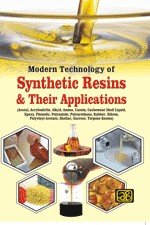Synthetic resin is typically manufactured using a chemical polymerization process. This process then results in the creation of polymers that are more stable and homogeneous than naturally occurring resin. Since they are more stable and are cheaper, various forms of synthetic resin are used in a variety of products such as plastics, paints, varnishes, and textiles. There are various kinds of synthetic resins; acetal resins, amino resins, casein resins, epoxy resins, hydrocarbon resins, polyamide resins, etc. The classic variety is epoxy resin, manufactured through polymerization, used as a thermoset polymer for adhesives and composites. Epoxy resin is two times stronger than concrete, seamless and waterproof. Polyamide resin is another example of synthetic resins. Polyamide resins are products of polymerization of an amino acid or the condensation of a diamine with a dicarboxylic acid. They are used for fibers, bristles, bearings, gears, molded objects, coatings, and adhesives. The term nylon formerly referred specifically to synthetic polyamides as a class. Because of many applications in mechanical engineering, nylons are considered engineering plastics. Resins are valued for their chemical properties and associated uses, such as the production of varnishes, adhesives, lacquers, paints, rubber and pharmaceutical uses. The applications of synthetic resins are seen in some important industries like paint industry, adhesive industry, the printing ink industry, the textile industry, the leather industry, the floor polish, paper, agricultural industry etc. As it can be seen that there is an enormous scope of application of resins hence it is one of the major field to venture.
Synthetic Resins are materials with properties similar to natural plant resins. They are viscous liquids capable of hardening permanently. Chemically they are very different from resinous compounds secreted by plants. Synthetic resins are of several classes.
The growth of the synthetic resins market can be attributed to the high demand from the packaging sector due to favorable properties, including lightweight and ability to act as an excellent barrier, which allows for their usage in applications such as barrier packaging, shrink wraps, and pharmaceutical packaging.
The major contents of the book are properties, manufacturing process, formulae of synthetic resins and applications of synthetic resins, derivatives of resins, use of resins in polymer field, alkyd resin technology, epoxy resins, manufacture of polystyrene based ion-exchange, phenol formaldehyde reactions, polycarbonates resins, polyester coating compositions, synthetic rubbers, modification with synthetic resins, water-soluble polymers, cross-linking of water-soluble coatings etc. This book also contains the list of manufacturers and dealers of raw materials, list of Chemical Plant, Photographs of Machinery with Suppliers Contact Details, Sample Plant Layout and Process Flow Chart.
The book will be very useful for new entrepreneurs, manufacturers of synthetic resins who can easily extract the relevant formulation and manufacturing process from the book.
TAGS
Alkyl and hydroxy alkyl alkylcellulose, Applications of Synthetic Resins, Best small and cottage scale industries, Business Plan for a Startup Business, Business start-up, Emulsion polymers manufacture, Formulation of Synthetic Resins, Formulation of Resins, Great Opportunity for Startup, How to Manufacture Synthetic Resins, How to start a successful synthetic resin business, How to start a synthetic resin production Business, How to start a synthetic resin production?, How to Start Emulsions of Synthetic Resin Business, How to start synthetic resin production Industry in India, Indene-coumarone resins, Manufacturing process of Acrylonitrile Resins, Manufacturing process of Actel Resins, Manufacturing process of Alkyd Resin, Manufacturing process of Amino Resins, Manufacturing process of Casein Resins, Manufacturing process of Epoxy Resins, Manufacturing process of Ion-exchange Resins, Manufacturing process of Phenolic resins, Manufacturing process of Polyamide Resins, Manufacturing process of Polycarbonates Resins, Manufacturing process of Polyesters, Manufacturing process of Polyurethane resins, Manufacturing process of Polyvinyl Acetate Solid Resins, Manufacturing process of Silicone resins, Modern small and cottage scale industries, Most Profitable Synthetic resin Business Ideas, New small scale ideas in synthetic resin production industry, Process of making synthetic resin adhesive, Processing of synthetic resin, Production of a synthetic resin, Profitable small and cottage scale industries, Profitable Small Scale synthetic resin Manufacturing, Project for startups, Resin Types and Production, Rosin & rosin derivatives, Rubber resins Formulation, Setting up and opening your synthetic resin Business, Shellac resins, Small scale Commercial synthetic resin making, Small Scale Synthetic resin manufacturing Projects, Small scale synthetic resin production line, Small Start-up Business Project, Start Up India, Stand up India, Starting a synthetic resin production Business, Start-up Business Plan for synthetic resin production, Startup ideas, Startup Project, Startup Project for synthetic resin production, Startup project plan, Sucrose resins, Synthetic resin Based Profitable Projects, Synthetic resin Based Small Scale Industries Projects, Synthetic Resin Business, Synthetic resin Making Small Business Manufacturing, Synthetic Resin Manufacturing, Synthetic resin manufacturing Industry in India, Synthetic resin manufacturing process, Synthetic resin manufacturing Projects, Synthetic resin method, Synthetic resin production, Synthetic resin production Business, Synthetic Resin Technology with formulation, Synthetic resin uses, Synthetic Resins, Synthetic Resins - Resin Chemical, Synthetic Resins and Polymer Emulsion, Synthetic Resins Technology book, Technological advances in the manufacture of resins, Technology of Synthetic Resins, Terpene resins, Types and applications of synthetic resin, Uses of rosin in the polymer fiel, Water-reducible resins
چکیده فارسی
رزین مصنوعی معمولاً با استفاده از فرآیند پلیمریزاسیون شیمیایی تولید میشود. سپس این فرآیند منجر به ایجاد پلیمرهایی می شود که پایدارتر و همگن تر از رزین طبیعی هستند. از آنجایی که آنها پایدارتر و ارزان تر هستند، اشکال مختلفی از رزین مصنوعی در محصولات مختلفی مانند پلاستیک، رنگ، لاک و منسوجات استفاده می شود. انواع مختلفی از رزین های مصنوعی وجود دارد. رزینهای استال، رزینهای آمینه، رزینهای کازئین، رزینهای اپوکسی، رزینهای هیدروکربنی، رزینهای پلیآمید و غیره. انواع کلاسیک رزینهای اپوکسی است که از طریق پلیمریزاسیون تولید میشود و به عنوان پلیمر ترموست برای چسبها و کامپوزیتها استفاده میشود. رزین اپوکسی دو برابر قوی تر از بتن، بدون درز و ضد آب است. رزین پلی آمید نمونه دیگری از رزین های مصنوعی است. رزین های پلی آمیدی محصولات پلیمریزاسیون یک اسید آمینه یا تراکم یک دی آمین با یک اسید دی کربوکسیلیک هستند. آنها برای الیاف، موها، بلبرینگ ها، چرخ دنده ها، اشیاء قالب گیری شده، پوشش ها و چسب ها استفاده می شوند. اصطلاح نایلون قبلاً به طور خاص به پلی آمیدهای مصنوعی به عنوان یک کلاس اشاره می کرد. به دلیل کاربردهای فراوان در مهندسی مکانیک، نایلون ها به عنوان پلاستیک مهندسی در نظر گرفته می شوند. رزین ها به دلیل خواص شیمیایی و کاربردهای مرتبط با آن، مانند تولید لاک، چسب، لاک، رنگ، لاستیک و مصارف دارویی ارزشمند هستند. کاربرد رزین های مصنوعی در برخی از صنایع مهم مانند صنعت رنگ، صنایع چسب، صنعت جوهر چاپ، صنعت نساجی، صنعت چرم، کفپوش، کاغذ، صنعت کشاورزی و غیره دیده می شود. همانطور که مشاهده می شود گستره وسیعی از کاربرد رزین ها از این رو یکی از زمینه های اصلی برای سرمایه گذاری است.
رزین های مصنوعی موادی هستند که خواصی مشابه رزین های گیاهی طبیعی دارند. آنها مایعات چسبناکی هستند که قادر به سخت شدن دائمی هستند. از نظر شیمیایی با ترکیبات صمغی ترشح شده توسط گیاهان بسیار متفاوت هستند. رزین های مصنوعی چند دسته هستند.
رشد بازار رزینهای مصنوعی را میتوان به تقاضای بالای بخش بستهبندی به دلیل ویژگیهای مطلوب، از جمله سبک وزن و توانایی عمل به عنوان یک مانع عالی نسبت داد که امکان استفاده از آنها را در کاربردهایی مانند بستهبندی مانع، کوچک شدن میدهد. بسته بندی ها و بسته بندی های دارویی.
مطالب اصلی کتاب خواص، فرآیند ساخت، فرمول های رزین های مصنوعی و کاربردهای رزین های مصنوعی، مشتقات رزین ها، استفاده از رزین ها در زمینه پلیمری، تکنولوژی رزین آلکیدی، رزین های اپوکسی، ساخت مبادله یونی بر پایه پلی استایرن، فنل فرمالدئید می باشد. واکنش ها، رزین های پلی کربنات، ترکیبات پوشش پلی استر، لاستیک های مصنوعی، اصلاح با رزین های مصنوعی، پلیمرهای محلول در آب، اتصال متقابل پوشش های محلول در آب و غیره. این کتاب همچنین شامل لیست تولید کنندگان و فروشندگان مواد خام، لیست کارخانه های شیمیایی است. , عکسهای ماشینآلات با اطلاعات تماس تامینکنندگان، طرحبندی کارخانه نمونه و نمودار جریان فرآیند.
این کتاب برای کارآفرینان جدید، تولید کنندگان رزین های مصنوعی که به راحتی می توانند فرمولاسیون و فرآیند تولید مربوطه را از کتاب استخراج کنند، بسیار مفید خواهد بود.
TAGS
آلکیل و هیدروکسی آلکیل آلکیل سلولز، کاربردهای رزین های مصنوعی، بهترین صنایع کوچک و کلبه ای، طرح کسب و کار برای یک کسب و کار راه اندازی، راه اندازی کسب و کار، تولید پلیمرهای امولسیونی، فرمولاسیون رزین های مصنوعی، فرمولاسیون رزین ها، فرصتی عالی برای راه اندازی , چگونه رزین های مصنوعی تولید کنیم, چگونه یک کسب و کار موفق رزین مصنوعی راه اندازی کنیم, چگونه یک تجارت تولید رزین مصنوعی راه اندازی کنیم, چگونه تولید رزین مصنوعی را شروع کنیم؟, چگونه امولسیون های رزین مصنوعی را شروع کنیم, چگونه صنعت تولید رزین مصنوعی را شروع کنیم در هند، رزینهای ایندن کومارون، فرآیند ساخت رزینهای اکریلونیتریل، فرآیند ساخت رزینهای اکتل، فرآیند ساخت رزین آلکیدی، فرآیند ساخت رزینهای آمینو، فرآیند تولید رزینهای کازئین، فرآیند تولید رزینهای اپوکسی، فرآیند تولید رزینهای اپوکسی، رزین، فرآیند ساخت رزین های فنولی، فرآیند ساخت رزین های پلی آمید، ساخت فرآیند تولید رزین های پلی کربنات، فرآیند ساخت پلی استرها، فرآیند ساخت رزین های پلی یورتان، فرآیند تولید رزین های جامد پلی وینیل استات، فرآیند ساخت رزین های سیلیکونی، صنایع مدرن کوچک و خانگی، سودآورترین رزین های مصنوعی ایده های جدید کسب و کار کوچک، صنعت تولید رزین، فرآیند ساخت چسب رزین مصنوعی، فرآوری رزین مصنوعی، تولید رزین مصنوعی، صنایع کوچک و کلبه ای سودآور، تولید رزین مصنوعی در مقیاس کوچک، پروژه برای استارت آپ ها، انواع و تولید رزین، مشتقات رزین و کلوفون، فرمولاسیون رزین های لاستیکی، راه اندازی و باز کردن کسب و کار رزین های مصنوعی، رزین های شلاک، ساخت رزین های مصنوعی تجاری در مقیاس کوچک، پروژه های تولید رزین مصنوعی در مقیاس کوچک، خط تولید رزین مصنوعی در مقیاس کوچک، پروژه کسب و کار راه اندازی کوچک، راه اندازی صنعت هند، هند، شروع تولید رزین مصنوعی کسب و کار، طرح کسب و کار نوپا برای تولید رزین مصنوعی، ایده های استارتاپی، پروژه راه اندازی، پروژه راه اندازی برای تولید رزین مصنوعی، طرح پروژه راه اندازی، رزین های ساکارز، پروژه های سودآور مبتنی بر رزین مصنوعی، پروژه های صنایع کوچک بر اساس رزین مصنوعی، مشاغل صنایع رزین مصنوعی، ساخت رزین مصنوعی تولید مشاغل کوچک، تولید رزین مصنوعی، صنعت ساخت رزین مصنوعی در هند، فرآیند تولید رزین مصنوعی، پروژههای تولید رزین مصنوعی، روش رزین مصنوعی، تولید رزین مصنوعی، استفاده از رزین مصنوعی، تولید رزین مصنوعی، فناوری مصنوعی مصنوعی، , رزینهای مصنوعی, رزینهای مصنوعی - رزین شیمیایی, رزینهای مصنوعی و امولسیون پلیمری, کتاب فناوری رزینهای مصنوعی, پیشرفتهای فناوری در ساخت رزینها, فناوری رزینهای مصنوعی, رزینهای ترپن, انواع و کاربردهای رزینهای مصنوعی, موارد استفاده از رزین در رزین fiel, resi قابل کاهش در آب ns
ادامه ...
بستن ...










